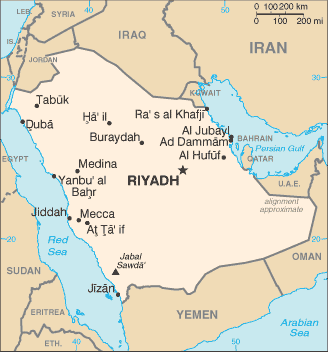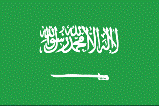|
|
Population: 34,268,528
Brief History of Saudi Arabia:
Saudi Arabia has the most oil of any place in the world. It ships more oil to the rest of the world than any other country. Saudi Arabia is also famous for the religion Islam and is home to Islam's holiest shrines in Mecca and Medina. The King of Saudi Arabia is called the Custodian of the Two Holy Mosques.Prior to the 7th century, most of Saudi Arabia was inhabited by nomadic tribes. In 570 Muhammad, the prophet of Islam, was born in Mecca. In the 7th century Muhammad united many of the tribes in Saudi Arabia. After he died in 632, his followers, the Arabs, began to expand the area of Muslim rule well beyond Arabia. In the 16th century the Ottoman Empire became prominent in the area taking control of the Persian Gulf and Red Sea coasts. In the 18th century the House of Saud began to emerge as a power. The founder of the Saud dynasty, Muhammad bin Saud, started the dynasty and it came to power until the Ottomans regained control in 1818. Another family, the Al Rashid, came to power in the late 1800s.
Saudi Arabia became an independent nation after the Ottoman Empire was defeated in World War I. Abdul-Aziz bin Saud regained power for the House of Saud. In 1932 the Kingdom of Saudi Arabia was formed with Abdul-Aziz was king.

The Geography of Saudi Arabia
Total Size: 1,960,582 square kmSize Comparison: slightly more than one-fifth the size of the US
Geographical Coordinates: 25 00 N, 45 00 E
World Region or Continent: Middle East
General Terrain: mostly uninhabited, sandy desert
Geographical Low Point: Persian Gulf 0 m
Geographical High Point: Jabal Sawda' 3,133 m
Climate: harsh, dry desert with great temperature extremes
Major cities: RIYADH (capital) 4.725 million; Jeddah 3.234 million; Mecca 1.484 million; Medina 1.104 million; Ad Dammam 902,000 (2009)
The People of Saudi Arabia
Type of Government: monarchyLanguages Spoken: Arabic
Independence: 23 September 1932 (unification of the kingdom)
National Holiday: Unification of the Kingdom, 23 September (1932)
Nationality: Saudi(s)
Religions: Muslim 100%
National Symbol: palm tree surmounting two crossed swords
National Anthem or Song: Aash Al Maleek (Long Live Our Beloved King)
Economy of Saudi Arabia
Major Industries: crude oil production, petroleum refining, basic petrochemicals; ammonia, industrial gases, sodium hydroxide (caustic soda), cement, fertilizer, plastics; metals, commercial ship repair, commercial aircraft repair, constructionAgricultural Products: wheat, barley, tomatoes, melons, dates, citrus; mutton, chickens, eggs, milk
Natural Resources: petroleum, natural gas, iron ore, gold, copper
Major Exports: petroleum and petroleum products 90%
Major Imports: machinery and equipment, foodstuffs, chemicals, motor vehicles, textiles
Currency: Saudi riyal (SAR)
National GDP: $687,700,000,000
** Source for population (2012 est.) and GDP (2011 est.) is CIA World Factbook.
Back to Geography Home Page



